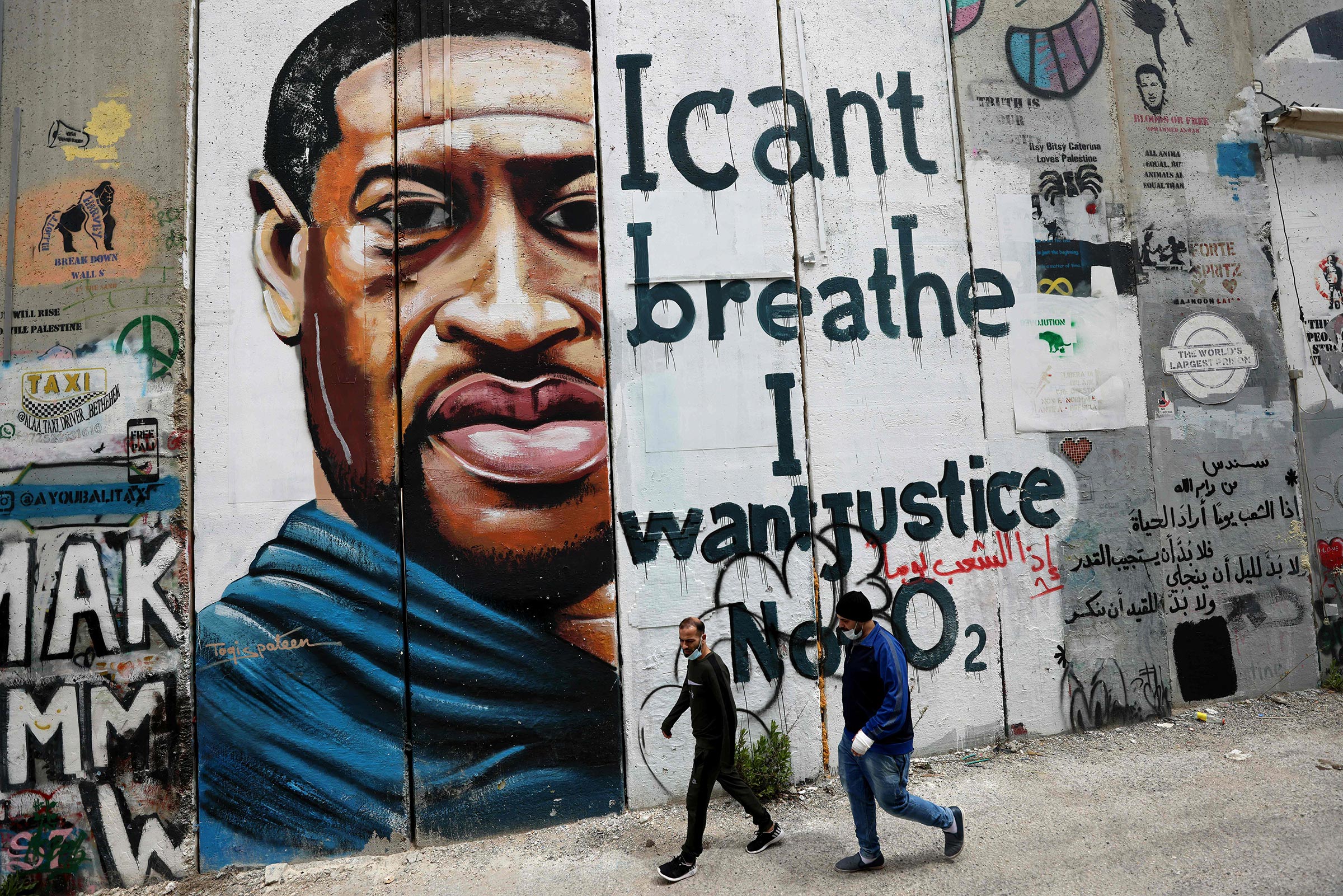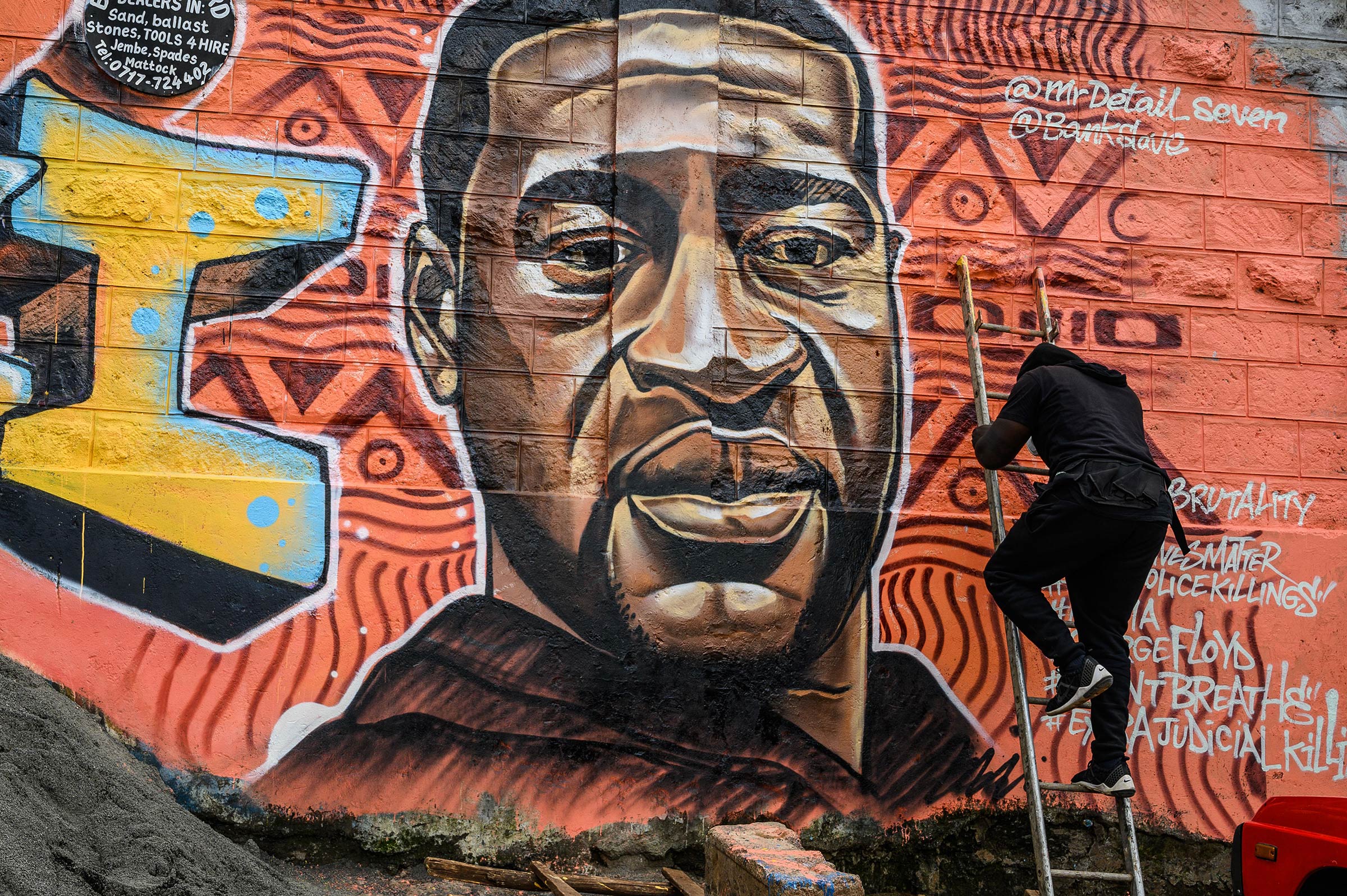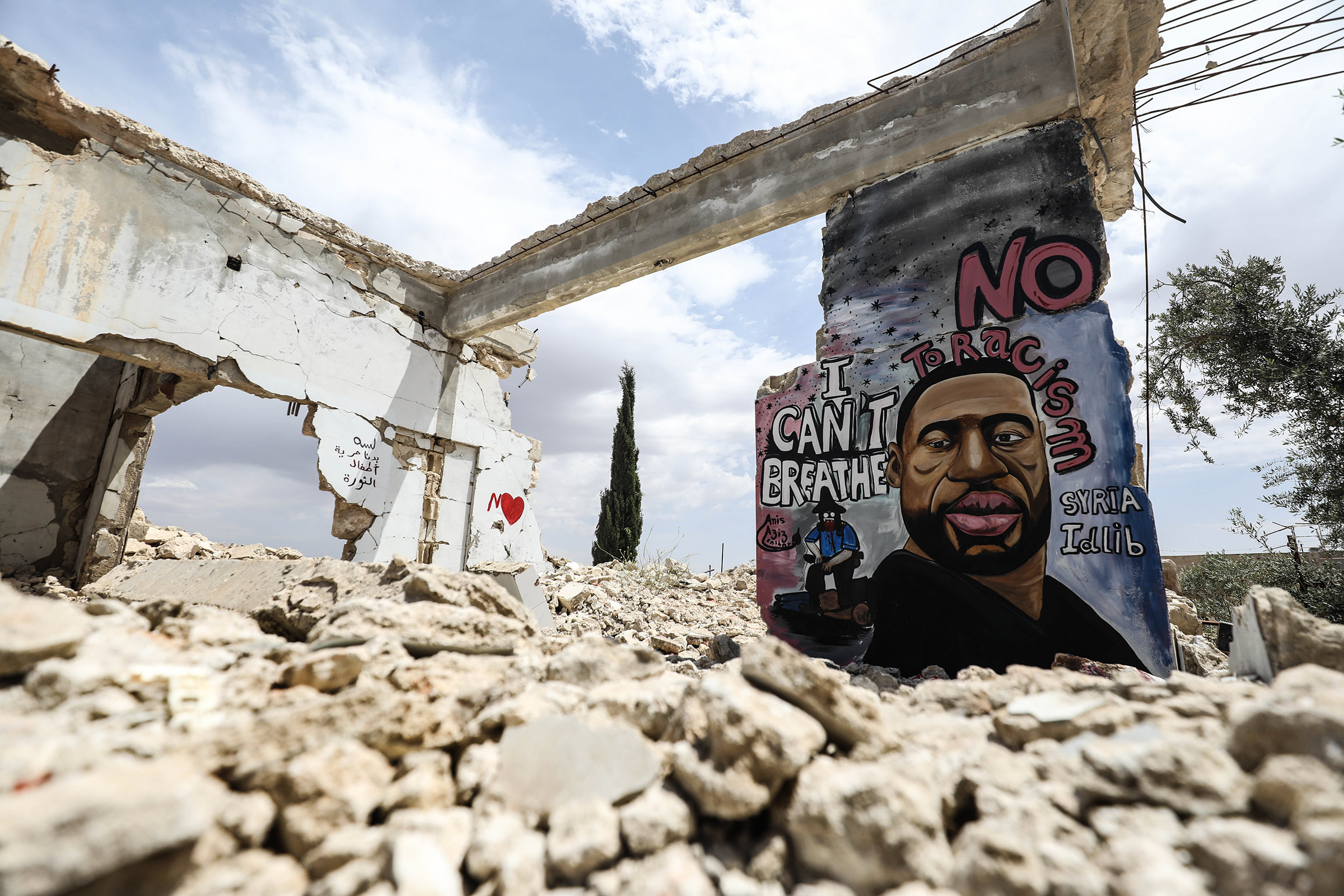
No art form embodies the creative response to the collective grief, outrage, and protest that followed the May 25, 2020 murder of George Floyd like the mural does. In the two years since Floyd was murdered by a police officer in Minneapolis, Minn., about 2,700 pieces of street art around the world have been created in response to his death, according to the George Floyd and Anti-Racist Street Art Database. Artist have emblazoned walls, sides of buildings, and stretches of streets with his image and the words “I can’t breathe” and “Black Lives Matter.”
The mural has long been one of the most engaging, if most ephemeral, forms of communicative art—a primarily public form, they’ve often served as a tool for revolution, community building, and remembrance. From Minneapolis to Bethlehem, here are five murals from around the world honoring Floyd, with reflections two years later from the artists who created them.
Minneapolis, U.S.

At the intersection of 38th and Chicago in Minneapolis, Minn., a space now known as George Floyd Square in honor of the man who died there, offerings are laid in front of a brightly colored mural that depicts Floyd’s face in front of a blooming sunflower. The flower is detailed with the names of other victims of police brutality in the U.S. The mural is the creation of artists Cadex Herrera, Greta McLain, and Xena Goldman, who painted the piece on the side of the Cup Foods grocery store, a block away from where Floyd was arrested and killed.
Read More: Two Years After George Floyd’s Murder, Minneapolis Is Still Struggling to Redefine Policing
For Herrera, the mural was a way to honor Floyd with respect and to disrupt the dehumanizing narratives that were emerging in the wake of his murder in the media.
“We wanted to portray George Floyd with humanity and personhood, someone was part of his community,” he tells TIME. “He was a family man, a person that had life and spirit and brought joy to so many people in his community.”
Herrera, whose art practice is grounded in social justice, says the piece was painted just a few days following Floyd’s murder and was a community effort. It was one of the first murals to pay tribute to Floyd, and the beginning of a larger creative response to the murder and to police brutality across the globe. Herrera hopes that the mural’s legacy is one that sparks social change.
“I hope that it has opened up the conversation about police brutality and that we keep a close eye on all of the sort of atrocities that have been committed by law enforcement,” he says. “Hopefully, this art piece is just a small part of the wider movement and wider conversation as to what we need to do to stop these things from happening.”
Berlin, Germany

For artist Jesus Cruz Artiles, also known as EME Freethinker, hearing about the fatal police brutality that Floyd experienced was discomfortingly reminiscent of a violent incident he witnessed as a teenager growing up in the Dominican Republic. Feeling both anger and hopelessness, he wanted to take action in the way he knew best: street art.
“I just wanted to say something, to do something,” he tells TIME. “This is a movement happening around the world.”
In the days following Floyd’s murder, Artiles painted a mural honoring him in the public park Mauerpark, which is famous for its strip of the former Berlin Wall, which has become a destination for graffiti artists. According to Artiles, who has created many pieces on the wall, while it’s commonplace for murals to be painted over in days, his mural of Floyd lasted far longer than any of his other work—something he considers to be a testimony to the importance of its message.
“We need to raise our voices against police brutality, against racism, because these things keep repeating,” he says. “I don’t want to have a reason to paint a mural like this again.”
Bethlehem, Palestine

On Israel’s separation wall running through Bethlehem, Palestine, a large mural of Floyd features the caption, “I can’t breathe. I want justice, not O2.” The image is the handiwork of Palestinian artist Taqi Spateen, who considered the parallels between the Black Lives Matter movement and the fight for Palestinian liberation as he created the mural.
For Spateen, the caption, which draws on Floyd’s famous last words, is a way to make a statement on how dignity and respect are just as vital for human life as oxygen is. “To be a human means many parts; we don’t just breathe oxygen, we breathe freedom, justice, peace, respect,” he says. Spateen’s decision to create the mural on the controversial wall of the West Bank is symbolic—he says he found connection between racism in the U.S. and ethnic cleansing in Palestine. “The wall is the face of racism, of occupation, it is something against humanity,” he says. He sees making art there as an act of resistance.
Alongside his mural of Floyd, Spateen also painted one of Iyad Al-Hallaq, a Palestinian man with autism who was shot and killed by Israeli police shortly after Floyd was murdered. This was to show the shared struggle of Palestinians, Black Americans, and all oppressed people.
“If I didn’t do it, I [would] feel like I’m not using my art—because to be an artist is to have a responsibility to care about humanity,” he says.
Nairobi, Kenya

When artist Allan Mwangi, known as Mr. Detail Seven, first saw the footage of Floyd’s murder in 2020, he felt a rising surge of anger about the injustice of the incident and the all-too-real threat of police brutality. The Nairobi-based artist knew it would be fruitless to just sit with this intense emotion, so he channeled it into art, creating a vibrant mural alongside his fellow artist, Bankslave, in the capital’s Kibera neighborhood.
“When I saw that video, it hit a nerve,” he tells TIME. “I thought it would be a good opportunity to express the way I feel about the whole situation by doing the mural.”
The mural pays homage to the life of Floyd and also calls out the horrors of police brutality; in another section of the wall, it depicts a police officer standing on top of a citizen. Adjacent to the drawing of Floyd’s face, the Swahili word Haki, which means “justice” is painted in bold, oversized letters.
Reflecting on the mural two years later, Mwangi believes the issue of police brutality that he tried to address through his art is still as urgent as ever, in both the U.S. and in Kenya, but he hopes that his piece has sparked more dialogue about the issue.
“I hope it’s a reminder that we are all human,” he says. “There’s no need to ever treat each other in such a way.”
Binnish, Syria

For Aziz Asmar, Floyd’s murder was intimately familiar, even if it happened halfway across the world. Filled with sorrow, he created a mural for Floyd on the remnants of a building that he says was a family’s kitchen before an airstrike destroyed it.
“The way he was killed, it is the same of thousands and thousands of people who were killed in the same way in Syria,” he says, speaking via an interpreter. “Our revolution is based on justice—we are against injustice totally. When George said, ‘I can’t breathe,’ I felt the same feeling and decided to draw the mural.”
Asmar, who teaches art workshops for children in Idlib, the last rebel-held enclave in Syria, says that turning to art in the face of injustice has been a way for him to reclaim his humanity, something that he believes is a universal desire.
“Drawing is a world language everyone can understand,” he says. “We are all brothers around the world, and we just want peace.”
More Must-Reads from TIME
- Cybersecurity Experts Are Sounding the Alarm on DOGE
- Meet the 2025 Women of the Year
- The Harsh Truth About Disability Inclusion
- Why Do More Young Adults Have Cancer?
- Colman Domingo Leads With Radical Love
- How to Get Better at Doing Things Alone
- Michelle Zauner Stares Down the Darkness
Write to Cady Lang at cady.lang@timemagazine.com